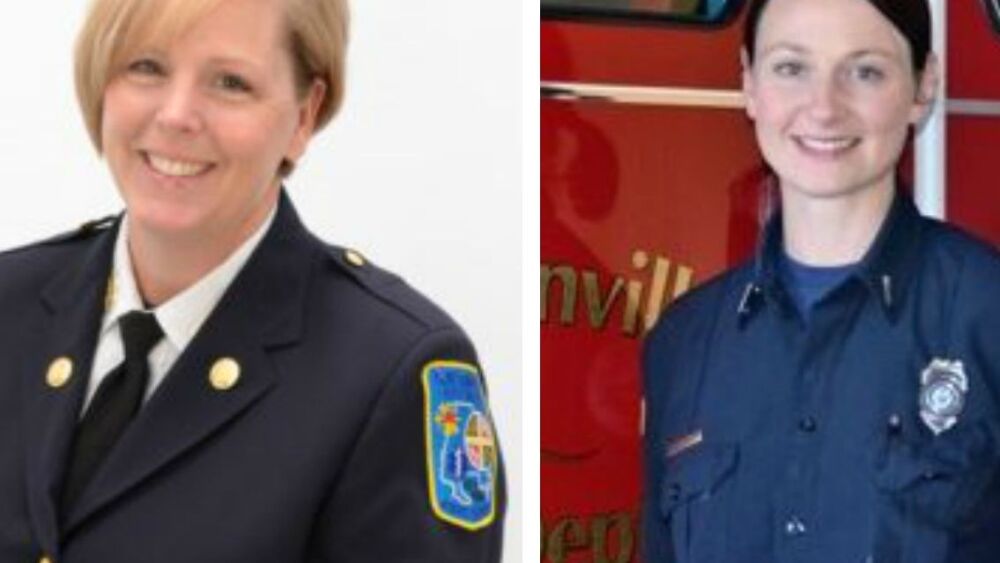NATIONAL HARBOR, Maryland — Two representatives from the International Association of Women in Fire & Emergency Services (iWomen) shared research about the specific issues threatening the health and safety of women in emergency services with attendees at EMS Today in a session titled, “Emerging Issues for Women in Emergency Services.”
Angela Hughes, captain at the Baltimore County (Maryland) Fire Department and president of iWomen, and Amy Hanifan, shift captain at the McMinnville (Oregon) Fire Department and vice president of iWomen, offered strategies to reduce fatalities and injuries among responders with a focus on women’s issues.
Top quotes on inclusivity in fire and EMS
Here are some quotes on inclusivity that stood out from Angela Hughes.
“To make a cultural change, you need to have ongoing training.”
“It’s 2019, we need to be an inclusive fire service.”
“We don’t want to lower standards, that’s how people get hurt or killed.”
Top takeaways on female emergency service personnel safety
Hughes and Hanifan broke down the dangers emergency services personnel face, how these risks differ in the female population and how to mitigate them. Here are the top takeaways from their presentation.
1. Apparatus and roadway safety
Year to year, the No. 1 cause of line of duty death in firefighters is cardiac events, according to the NFPA. However, in women, according to research and iWomen partnering organizations, the number one cause of death is trauma, caused primarily by accidents operating apparatus and on the roadways.
When you examine the data, the number of “struck by” incidents resulting in the death of emergency services personnel are almost double in the female population than the male.
Citing EVOC, Emergency Responder Safety Network traffic incident management and IAFF resources, Hughes noted the five leading causes of injury or death on the roadway:
- Lack of seatbelts. Eighty percent of firefighters killed in collisions were not wearing their seatbelts, Hughes noted, encouraging attendees to push to make seatbelts mandatory and then hold people accountable. “The driver should not leave until everyone is belted; no excuses,” she said.
- Lack of apparatus maintenance. “We need to address the defects small and large,” Hughes cautioned. “Things like wear on tires and oil leaks will turn into bigger issues.” She called for frequent inspection and repair before maintenance issues become safety issues.
- Excessive speed and loss of control. Approximately two-thirds of fire apparatus crashes happen while en route to an emergency situation. Beware of “siren syndrome” and push for new lights and siren protocols, Hughes advised.
- Apparatus operation and distractions. Too often, emergency apparatus drivers are undertrained or distracted. Promote the need for training and keep operators completely focused by having the passenger manage traffic lights, the GPS and other distractors.
- Intersections. It’s no secret most ambulance and apparatus crashes occur in intersections. Promote complete stops in your driver training. “It takes just a few seconds and it’s better to get there safely than not at all,” Hughes stressed.
2. Combating cancer in female firefighters
While there are very few studies examining the incidence of cancer in female firefighters, the link between firefighting and cancer is undeniable, and departments across the country have reported a higher incidence of thyroid, cervical, bladder and breast cancer in their female firefighters.
Hanifan urged attendees in the fire service to implement a gross decon process.“ At the very least, keep wipes on your medic or engine, and wash down your face, hands and clean your neck really well before putting anything in your mouth,” she said. “If you are interior in the fire, you should be getting a good wash down.”
She shared a PPE pollution video created by the San Francisco Fire Department for the Women Firefighter Biomonitoring Collaborative illustrating how easily contamination can spread to other areas of a firefighter’s body, gear, apparatus and station without decon.
This also applies to EMS professionals staging on fire scenes, Hanifan noted. “You are just as exposed to the toxins and contaminates.”
3. Anxiety, suicide ideation in female emergency services personnel
Hanifan outlined some of the mental health stressors unique to women in the emergency services contributing to their higher risk of anxiety:
- Harassment: verbal, non-verbal and physical
- Discrimination
- Sexism
- Lower job association (i.e., “imposter syndrome”, a pattern in which someone struggles to identify In the position they’re in and believe they don’t belong or aren’t qualified)
- Higher levels of coworker conflict
While there are alarmingly high rates of suicidal thoughts and behaviors reported among both genders, Hughes noted female emergency services personnel are less likely to report suicide attempts, which makes it difficult to accurately track the impact in this population. Even so, women in the emergency services die by suicide at a higher rate than in any other workforce.
Hughes shared the RAILS method for identifying suicide warning signs:
- Reckless/impulsive. Is the person suddenly driving recklessly, did they just buy a gun, or are they exhibiting other signs of reckless impulsivity?
- Anger. Is the person exhibiting unusual, explosive anger? This is usually taken out on family, friends and coworkers.
- Isolation. If the person who normally comes to drills, meetings, conferences is suddenly bowing out or making excuses, that could be a warning sign. Check on them, make sure they’re OK, Hughes advised.
- Loss of confidence in skills and abilities. If a high-performing firefighter or paramedic just isn’t showing up anymore, if that paramedic known for nailing every intubation just isn’t getting the job done; this could be a sign.
- Sleep deprivation. If someone tells you they just can’t sleep or are worn down because they aren’t getting any sleep, this is a red flag.
The NFFF suggests you ACT if you see the warning signs in a colleague:
- Ask: How do they feel, what are they thinking?
- Care: Demonstrate that you care, check in, send a text to let them know you’re thinking about them.
- Take: Physically take them to get help. Sit outside and wait while they speak to a counselor. Don’t ask questions, just be there.
Additional resources on EMT, paramedic and firefighter safety
Learn more about keeping female and all emergency services personnel safe in your agency or department with these resources from EMS1 and FireRescue1:
- Operating in the roadway: A WMD approach to traffic incident management
- Go back to the basics for highway incident operations training
- Fire Chief Digital: How to prevent injury and death on the road
- How to reduce ambulance collision death and injury
- Importance of TIM, physical health highlighted by NFPA 2017 LODD Report
- NFPA: 2017 LODD report is lowest in over 40 years
- Blind spots: Distracted driving in EMS
- Decon alley: 5 steps to doffing firefighter PPE before rehab
- New research underway to determine cancer risk facing women firefighters
- 8 habits that expose firefighters to cancer-causing toxins
- Suicide is killing our paramedics: What’s to blame and how to stop it
- Research Analysis: More than 1-in-20 EMT deaths are due to suicide
- Increasing suicide rates among first responders spark concern
- Understanding, preventing harassment in the EMS workplace
- Enough is enough: 5 ways to end bullying in fire and EMS
- The tragedy and disgrace of bullying in EMS and fire
- EMS students conduct study on bullying, harassment, critical stress














